
| SECURING THE TOWER |

Work began to make the North Tower of the Rocca di Pierle safe

The new ownership of the Rocca di Pierle, after having purchased the fortress in November 2007, immediately took action to comply with the trade union ordinances that required the safety of the tower. Contacts were made with the design firm which took charge of the technical part of the work. Prepared a plan of interventions was the time to start the tender to contract the works. At the end of the tender and stipulated the contracts we were able to open the construction site. The works began precisely on 19 May 2010 with the arrival of the crane and ended on 10 October with the delivery of the roof on the top of the tower. Within five months, Pierle's tower was secured.

The top of the tower was rather battered and these works have served to give it a more decent appearance, to reduce the risk of falling loose materials and to protect it from the elements. Specifically, the yard has foreseen the following phases:


The construction site
The construction site was opened on May 18, 2010 and the road that passes through the town of Pierle was closed for a week, that is the time necessary for the crane to finish the first cleaning of the ivy and carried within the walls all materials for the scaffolding and construction machinery. Subsequently, the construction area remained limited within the castle walls. The crane had to come back two more times. The first after the scaffolding was almost complete in order to transport the freight elevator and the materials for the reconstruction of the towers inside the fortress. Finally the second at the end of this phase to get the machines out of the yard.

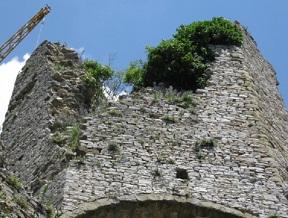
Removal of loose stone materials
The very first phase of the construction site was to search the top of the tower with the basket so that the operators could make all the loose stones on the top of the tower fall to the ground, thus making it possible movements at ground level. In this phase, the windows of the keep were also propped up and the cantonals were checked which showed subsidence due to run-off. In this phase the part of the tower that required the most work was the one turned towards the inside of the castle where there was a large opening full of debris and with thick vegetation.

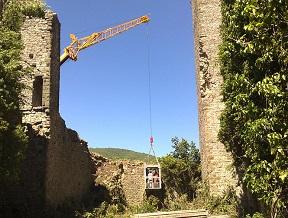
Ivy removal
This phase took almost a week because the affected area was very large. Initially the ivy was removed from the north wall, then from the tower, then the one on both sides of the keep for a perimeter of 12 meters, and finally the one from the North-West tower. The two operators worked from inside the basket using manual tools but this was often not very effective. The best results were obtained by using the weight of the basket to crush the ivy mantle downwards and causing it to detach by gravity. In this way it was possible to cause the detachment of large heaps of ivy, greatly accelerating the work.


Scaffolding up to the male level After cleaning the ivy, the scaffolding began. A joint tube scaffold was used and not fixed frames because the shape of the tower was too complex for this solution. The scaffolding was purchased by the owners of the fortress. The first levels were erected by lifting the pipes by hand, then later with motor winches. Only later, when the scaffolding had already risen beyond the keep, was a 200kg freight elevator installed to allow easier transport of the building materials for the rebuilding of the tower.


Preparation of cantilevered scaffolding bases
An important phase of the assembly of the scaffolding began when the twelfth level was reached, which made it possible to surpass the body of the castle. The next level required the perimeter of the scaffolding to embrace the entire tower. So from the thirteenth floor onwards, the scaffolding would become cantilevered.
To distribute the load also on the walls of the castle, which at this point are 1.5 meters wide, two reinforced concrete bases were built to support the cantilevered thirteenth floor. The realization of the two bases required the execution of uncoupling with the relative waiting times.

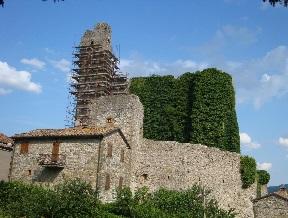
Cantilever scaffolding around the tower The realization of the scaffolding floors from the thirteenth onwards took a little more time, both for the trapezoid shape of the perimeter and for the lifting time of the materials that lengthened in step with the height. At this point, a freight elevator was installed on one side of the scaffolding, so that the building material could begin to be lifted to restore and close the tower. The use of this machine has made it possible to significantly streamline the workload of the workers. Lifting times and effort have been drastically reduced.


Emptying the tower from debris The tower at its top was in quite bad shape, the oves side was destroyed over the centuries and the two rooms were filled with stone material and dusty sediments. Above them they found space with arboreal vegetation, brambles and the inevitable ivy. At the top he had also rooted a small tree. All this material has been removed until it almost completely recovered the level of the original floor. This activity was all done manually and took several days. A pentagonal-shaped interior has been created with two windows and two doors. It was later discovered that two staircases, obtained in the masonry, start from this environment, which reach the top of the fortress.

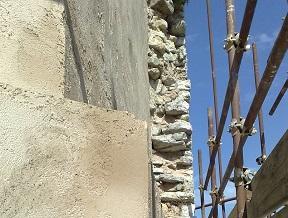
Restoration of the perimeter continuity of the tower
At this point, the masonry works began which had the aim of restoring the continuity of the tower. In this way the subsequent action of the tie rods should guarantee the stability of the tower. Anti-seismic bricks were used which were kept more internally than the plane of the walls in order to allow a subsequent covering. The two walls thus obtained were then plastered for the need to ensure the waterproofing of the fortress.


Contrasting internal scaffolding
Parallel to the construction of the wall, an additional scaffolding was installed inside the tower environment, useful for carrying out the masonry works also on the internal side. This series of innocent tubes were placed against the perimeter walls of the room so that they could counterbalance the thrust that the ropes of the hoop would develop once installed. It took three orders of pipes to complete this installation, a sign that the original room was more than six meters high.

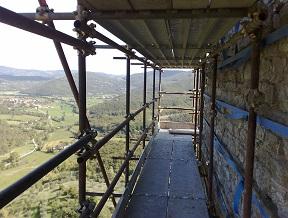
Hooping with ropes
The hooping of the tower took place with the aid of 30 nylon ropes and over 100 lever ratchets. On the corner of the tower wooden boards were placed to distribute the load that the ropes exerted on the wall. Each hoop was composed of several ropes and more ratchets both to make pretensioning and loading easier and for the need to embrace the 32-meter perimeter of the tower. This intervention was placed to guard against any detachment of portions of masonry.


Consolidation and top case
During all the ascent phases with the scaffolding all those situations of instability of the single parts were remedied. The loose stones have been eliminated, the washed-out mortars have been roughened and the gaps and cavities in the wall faces have been stitched up. Once reached the top of the tower, a top case was built with the aim of preserving the integrity and reducing the effects of atmospheric phenomena.


Roof installation
To complete the safety work, a sloping roof was created to temporarily protect the tower from bad weather. This structure was built with two layers of crossed spruce boards, anchored both to the internal and external scaffolding. On top of them, a burnt-on bituinous waterproofing sheath was spread. To reduce the risk of detachment of the roof, it was left open on two sides and stabilization stones were placed above it. The final result is visible on many aerial videos shot with drones in the following years.

At the same time, all those safety measures were carried out aimed at guaranteeing the safety of all the site personnel and equipment.


Bauletto on northern section of the walls
The first masonry intervention is that which concerned the northern part of the walls, that is the portion above which all the materials handled with the 65-meter crane passed. To ensure the safety of the operators assigned to the loading, a safety top case was first built.
The project for the recovery of the cone provides for the reconstruction of the baletto of all the parameters of the cone, only in this excerpt of works were carried out only interventions of utmost urgency for the safety of the people and which in any case only involved the safety of the places facing the tower, as required by the ordinances of the Mayor of Cortona.


Securing the male doors
A second security intervention was that relating to the two male entrance doors. Due to the washout of the limestone stones that made up the arch it supported, the stones above the entrance opening were supported only by the adhesion of the cement mortar. To eliminate the risk of collapses, an anti-seismic brick infill with a steel lintel was created. This masonry remains several centimeters back from the original parameter in order to allow for a possible stone cladding. This coating will be carried out following the indications of the superintendency.


Last Update 19/03/2011
| 
